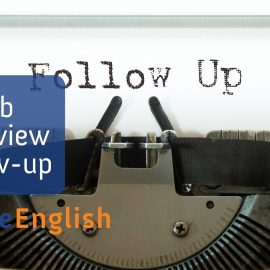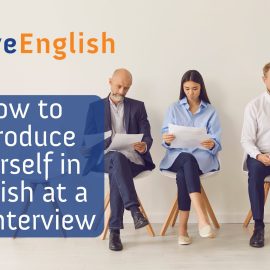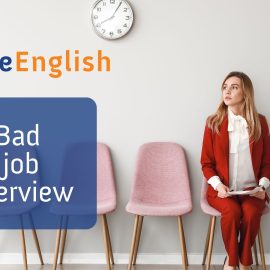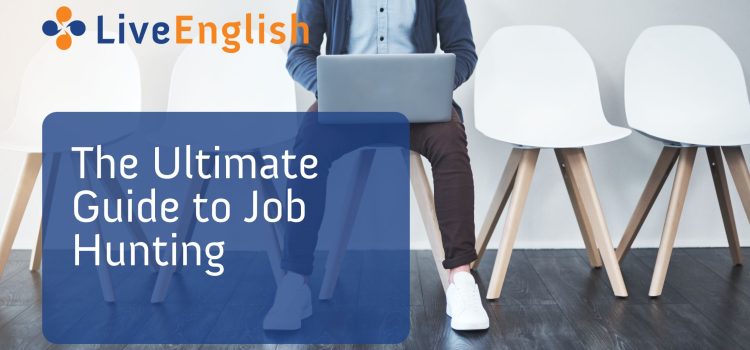
2020 was a transition year. The Coronavirus crisis has accelerated the trend that was already felt in HR and recruitment.
Finding a job has evolved greatly, and we need to adapt to a new world. Some industries have been touched by the Covid-19 crisis more than others, but some are growing even faster than before. Be assured, there are still tons of companies that are hiring. So if you’re looking for a job, there is somewhere a job for you, you just need to find the right way to get to it.
This is a guide for professionals who are not native-English speakers and who feel that they need to enhance their English skills in preparation for a new job or career.
This guide will take you to the 4 areas you need to focus on to find a job this year, and 4 areas where English skills are essential.
Things have changed: the way companies approach candidates is now digital, the CV we write is screened by AI (Artificial Intelligence), the cover letter should not be underestimated, the interview is going more and more digital, be ready for that, and your communications skills in English are more than ever scrutinized and tested. For all these steps, English is a key skill to succeed in your job hunting since an insufficient level of English could jeopardize your recruitment even though you tick all the other boxes. A great way to prepare for your next job interview in English is to take English classes via Zoom that will focus on helping you with your job hunt.
Whether you are unemployed and are looking to get into a new company to use your skills and talents, or you are still in a company where you are plateauing and need a change, job hunting is a project in itself, and should definitely be prepared. If you have the right motivation, skills, and strategy, you’ll be on your next professional challenge very soon.

Unit 1: Building your professional digital identity on LinkedIn
LinkedIn is a wonderful tool for people looking for a new professional challenge as well as for recruiters looking to add people like you to their team. If you don’t have a LinkedIn profile, it’s time to get into it. If you already have one, check you are following our advice.
What makes a good profile on LinkedIn?
LinkedIn is the social media for professionals. Make sure you use your real name, you want to be found!
Picture and headline
The picture and the headline are the first elements your recruiter will see on your LinkedIn profile.
For the picture, it’s highly recommended to use a professional picture. The picture is really important. For a start, I see too many profiles without a picture and too many profiles with an irrelevant picture, taken during the holidays or at a party. The picture should be quite recent, your face should take at least 60% of the frame, choose a background that looks neutral, wear clothes you would wear at work, and smile! You want to appear friendly and warm.
The headline should clearly explain what you do, and highlight the value you bring. Think of keywords recruiters could look up if they were to search for someone with your profile and add them to your headline.
Summary (About section)
The summary or about section is like an “elevator pitch”. Show what people or companies should expect from you. Highlight your strengths, tell us about your current job, and what quote represents your values or what you aspire to be.
LinkedIn also gives you the possibility to share rich media, and use it to show projects you’ve worked on, your company.
Experience
For each job you’ve had, write a couple of sentences to talk about your wins, what value you’ve brought to the company.
Skills and Endorsements
Enter the skills you feel are important to highlight, and your connections will be able to endorse those skills.
Recommendations
Having others recommend you is the validation of your work and who you are as a professional. You can ask current and former colleagues, managers, clients, and partners to write a recommendation on your LinkedIn profile. It’s a great asset to your LinkedIn profile.
Joining groups
Join groups in the industry, your company, your university, etc.
Now, take a look at your profile and imagine you’re a recruiter. What does he or she see? Are you using powerful words, and strong statements? Is the about section clear and to the point? Is your professional experience described clearly? The bottom line is: would you hire that person?
If the answer is yes, it’s time to use the power of LinkedIn to find a job. If you feel it’s still not right, take some time to fine-tune what is necessary.
Please note that your profile in English needs to be professional-looking, free of jargon, and, of course, in proper English. Your profile is not static, update it on a regular basis and put the emphasis on what matters at the moment.
Maintain your LinkedIn Presence
A lot of communication on LinkedIn is done in English. Show your English skills and share resources in English if relevant to the job you’re aiming at.
LinkedIn should definitely be part of your job-hunting strategy. Go to LinkedIn daily and get the conversation going. There are a few ways to increase your visibility.
Share content
If you’re starting with LinkedIn, it might be easier and less time-consuming to start sharing content. The content you should share can be relevant articles connected to your industry, company, or job, stories, news, quotes, and inspiration.
Comment on other people’s posts
Get visibility by sharing short comments with your own personal insights on industry trends or news. Comment on what you are interested in, what you like talking about it, and what shows your personality and expertise. Be active on other people’s posts on a regular basis. You want to be visible.
Create articles
LinkedIn allows you to publish blog posts on your profile as a way to express your opinion and to share advice with your network. This is a great opportunity to show your expertise and knowledge of your field. It can be done as a one-off if you get inspired by a certain topic that could interest your LinkedIn network.
Create posts
Posting on the other hand should be done regularly, 2-3 times a week, even daily if you can. It should be part of your LinkedIn routine to come up with ideas and post about them every week. The secret is to create engaging content that your audience will relate to.
Make sure you have a call to action at the end of your post asking your audience for their input in the matter.
What to post about?
- Your experience and impressions with your job, company, or industry.
- Your successes or your failures and how you’ve learned from them – make it personal, stories and anecdotes can add to what you are writing about.
- Your expertise by giving advice and context to events. Help readers understand trends in your industry or the larger challenges surrounding your industry.
- Meaningful conversations with your readers.
When your followers leave a comment on your post, make sure to engage with them, and reply to their comments.
Make connections
Connecting to LinkedIn members should be done strategically to have the best results.
Who should you connect with? your team, your manager, leaders in your organization, people you’ve met at conferences or networking events, clients you work with regularly, university alumni, past colleagues, and people you know in real life who can refer you to a new job in their company, thought leaders in your domain and influencers.
If you’re reaching out to connect with someone you don’t know, remember to introduce yourself and include a reason as to why you’re connecting.
LinkedIn etiquette
It’s perfectly acceptable to add people to your LinkedIn network even if you don’t know them in real life. It’s good practice though to add a note and let them know why you think it would be relevant for both of you to connect. Search for contacts on LinkedIn according to relevant keywords. From there, it’s a lot easier to build your network.
Your LinkedIn profile should be part of your email signature, and encourage people you are in touch with by email to connect with you on LinkedIn.
When you have a first contact before a job interview, feel free to connect on LinkedIn. They will more likely look at your profile on LinkedIn and get more information than what they can see in your CV.
Would you like to learn more about LinkedIn and how you can leverage your profile to find a job in your industry? We’re opening a Career Bootcamp soon. Fill out this form and we’ll be in touch with you shortly.
https://forms.gle/MVzem3xoe9zFEgWq8
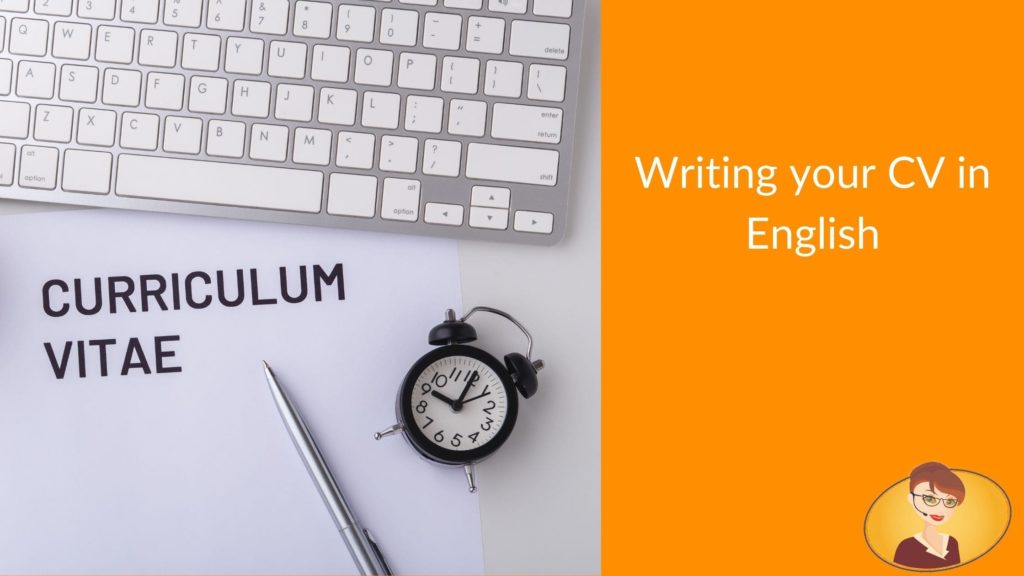
Unit 2: Writing your CV in English
For many people, writing a CV or Curriculum Vitae is the first step to getting a job, or moving up into a better job. You need to have a resume that will show your potential employer your abilities in your chosen profession.
It is very important to use a standard font for your resume, Times Roman, Ariel, or Verdana, you don’t want to distract the employer by using a fancy font. Make sure that you proofread for spelling and grammar.
General tips
You want your resume to show that you are creative, yet able to work in a team and be a self-starter. You need to “put your best foot forward” as they say.
- For most job positions a resume should be one page, more than that, the employer usually won’t read the second page. For high-level executive positions, a two-page resume is acceptable.
- You should tailor, that is, change your resume depending upon the job position that you are applying for. If you have many different job skills and are applying for jobs in different industries, you might want to change the emphasis of your CV to fit the different jobs.
- If you do not have much experience or are just starting out in the job market, you can use your life experience to highlight your abilities. Use volunteer work that you do, and extracurricular activities. Did you receive any awards, or other achievements while at university?
- Translating education. If your CV is in English for a company that is not familiar with your local educational system, make sure you use words that they can understand
- Many people find it difficult to assess their English level. If you have done a proper English level assessment exam, make sure to include it in your CV, for example, your TOEIC score, First Certificate exam, etc. You can also use the European framework A1, A2, B1, B2, C1, C2.
Artificial Intelligence
AI has been part of the recruitment process for a while now. Some companies get thousands of CVs every month. To help them filter the best candidates, AI screens CVs for the right skills as a first step.
So when you write your CV, think about it.
- make sure to include keywords that are relevant to the job you’re looking for: skills, experience, job titles, etc.
- prove your English level with concrete facts like TOEIC score, FCE exam, etc.
- help the computer screen your CV properly, only use text, the information in images and other graphic elements might not be read
Cultural differences
- Pictures on CVs: they are at this time optional unless the employer asks for them. If you do put a picture, make sure that you have a professional photographer take a “headshot.” Make sure that the picture is recent, and that you look professional, wearing a suit, and for women, make sure that your makeup is appropriate for the business world.
- Length of CV: For most job positions a resume should be one page, more than that, the employer won’t even read the second page. For high-level executive positions, a two-page resume is acceptable.
- British vs. American: In a British CV work experience is more important than education. If you are applying for a job in England, but the work experience section first and then the education. In the end, put your age, marital status, and driver’s license information. A CV in England includes also a listing or summary of your educational and academic backgrounds as well as teaching and research experience, publications, presentations, awards, honors, affiliations, and other details.
If you are applying for a job in the United States, leave out a picture, marital status, and age. It is against the law for an employer to discriminate based on these factors so leave it out. Let your education and work experience work for you.
Would you like to learn more about how to write your CV in English? We’re opening a Career Bootcamp soon. To learn more about it, please fill out this form and we’ll be in touch with you shortly.
https://forms.gle/MVzem3xoe9zFEgWq8

Unit 3: The Cover Letter in English
Your cover letter is the first contact that you have with your prospective employer. You need to make sure that it is professional, neat, and complements your resume or CV. You want to include information that is more job-specific than you can in a one-page resume. If you have won an award, then you should mention it in your cover letter.
General tips
You want your letter and resume to stand out from the rest that the hiring manager has received.
Keep a copy of your cover letters. When you get a callback, it is best to know exactly what you have written to the prospective employer.
When emailing your resume, the cover letter is the body of the email, and then you attach the CV. If your CV is in a pdf format, have the contact information in the email, in a format that is easy to cut and paste. This way it will be easy for the hiring manager to contact you, and there will be less chance of a mistake on their part.
The cover letter is only one page in length. Give a few details of your past work, and let the hiring manager want to call you in for the interview.
Find out the name of the hiring manager or the person who will be conducting the interviews. Research the company before you write your cover letter and relate your past experience to the new company.
7 mistakes to avoid at all cost
- Spelling mistakes: this is basic but unfortunately we still see a lot of cover letters with spelling mistakes, typos, and grammar mistakes! Review your letter before you press the send button and have some review for you to make sure it’s flawless. Make sure that your spelling and grammar are perfect and this includes the name of the company and the hiring manager.
- Using informal English: a cover letter should be formal, the expressions, vocabulary, and tone should be all consistent
- Writing a very long message: recruiters get a lot of CVs, and they want to know if you would be relevant to the job they posted, they only have a limited amount of time to review your letter, make it to the point
- Sending the letter in a format that is not supported by every computer → pdf
- Focus on a simple message: do not use the jargon that was used in your previous company, and make sure what you write is understandable even if you are not from the field
- Be too short or ignore the requirements: companies usually give instructions about what information they need. Don’t ignore that. It’s easier for them to press the delete button than to call or email you to get more information.
- Use negative words: be positive! Your copy should be about your strengths and experience.
Would you like to learn more about how to write a cover letter in English? We’re opening a Career Bootcamp soon. To learn more about it, please fill out this form and we’ll be in touch with you shortly.
https://forms.gle/MVzem3xoe9zFEgWq8
Job interview Express
Do you have a job interview in English in the coming days? We have the solution for you!
Take an intensive job interview preparation course of 5 PRO sessions (2.5 hours) before your job interview. If you feel a bit rusty, this will give you the confidence you need to succeed and get your dream job!
It’s best to contact us before you register so that we can check availability.
If you have more time to get ready, check out our regular English courses.
Unit 4: The Digital Job Interview in English
The digital job interview in English. With Coronavirus, digital interview has been more widespread even for jobs whose office is around the corner from you. Make sure you are ready for it. We are here to help you with some tips for a successful online interview.
Making a good impression on your Video conference job interview
Job interviews can be overwhelming, especially if they are done on the Internet. You want to make a good first impression and impress your recruiter.
Test your camera and microphone before the interview. Place your webcam correctly. For a better angle, you want to position your webcam so it’s above your eye-line, angled slightly downward. Place the webcam (or laptop for built-in cameras) on a stack of books or a box.
Download in advance the video conference tool/app that is going to be used for the interview. Don’t wait until the last minute to do it, you don’t want to be late.
Background. Choose a room where you have a clean background, a wall, a bookshelf, and a nice picture. Don’t have a window in the background to avoid bad lighting. Try to set your interview in a quiet place.
Dress like you would for a regular interview. Even if you’re not going to meet anyone face to face, you still need to dress appropriately for a video interview. You’ll want to wear the same professional clothes that you’d wear to an in-person interview.
Show your social abilities. Even if the job interview is on Zoom or Skype, don’t underestimate body language:
- make eye contact. To do it, resize and move the window displaying the interviewer’s image, so it is as close to the camera as possible. This way your eyes will be focused on the camera, letting your interviewer feel you’re looking right at him.
- Adopt a good posture, and sit straight up in your chair.
- Nod and smile when appropriate. Show your interviewer that you’re giving him your full attention. A smile shows you’re pleasant to work with and have reasonably good social awareness.
- Use hand gestures when it feels appropriate. Communicate using your body, but keep your movements close to your body and stay on screen.
- Speak clearly and enthusiastically. Make sure you’re heard by your interviewer.
- Practice your job interview in English. Practice makes perfect! Interviewing is a skill (just like tennis, golf, or chess), so make sure to practice. Do it with a teacher or a friend and ask for feedback. Most important, record yourself answering questions on your webcam or phone.
Know your answers
Most of the job interview questions are standard questions to get to know you and see if you’re a good fit for the company. Your answers should be concise – get to the point quickly! Every time you make a point, make sure you have good examples to back you up.
You want to highlight your strengths, so make sure that your answers convey them properly. You want to show you are motivated for the job – ask yourself why you want this job and what makes you the perfect candidate for it.
Integrate all these points into your answers.
Here are some questions that are often asked in job interviews:
- Please tell me about yourself. Learn how to introduce yourself in different ways. Talk about your professional experience with the intention of highlighting your strengths, skills, and expertise.
- What are your strengths and weaknesses: you cannot go to the interview without preparing this classic question.
- What do you like/dislike about your current position?
- Can you describe a project/task that you’ve done and would define as successful?
- Can you tell me about a mistake you’ve made? (When preparing an answer for this, also make sure you say what you’ve learned from this mistake).
- Why did you leave your job? (If it’s because of the coronavirus crisis, it’s perfectly understandable. The unemployment rate has skyrocketed in the last few months following the outbreak. Don’t feel bad about it. Be honest with the reasons, be positive about your previous job, and don’t talk badly about your previous company, boss, or colleagues).
- What do you find attractive about this position?
Check the 30 useful sentences for a job interview in English.
The job interview will also be the opportunity for the recruiter to test your motivation, prepare what you should know about the company, be familiar with the industry, and stress what’s in there for them.
If part of the interview or all of the interview is in English, make sure you know how to answer these questions and are comfortable with key vocabulary.
At the end of the job interview, always have a question about the job or the company ready to be asked if they give you the opportunity, restate how much you are interested in the position they offer, and summarize why you’re the right person for the company.
Following up with the interview
It’s good practice to send a thank you email to the recruiter to let them know how much you enjoyed talking to them and that you are looking forward to the next step.
Would you like to learn more about how to prepare for a job interview in English? We’re opening a Career Bootcamp soon. To learn more about it, please fill out this form and we’ll be in touch with you shortly.
https://forms.gle/MVzem3xoe9zFEgWq8
Conclusion: Once you get the job
English is becoming more and more important. Jobs are more and more international and require you to be fluent in English. Getting the right job requires the right skills.
Once you get your dream job, make sure you can deliver and go beyond expectations.
If you need help with your English, we can help 👇



